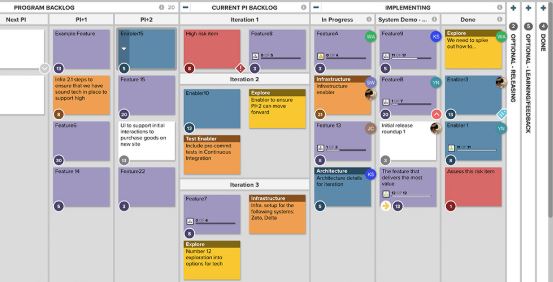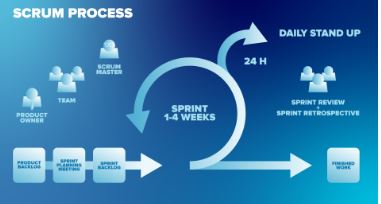Introduction to Kanban
Kanban is a widely used lean workflow management that supports defining, managing, and improving services that offer knowledge-based work. This allows the teams to visualize the tasks and boost efficiency with ongoing improvements. Basically, the Kanban boards display daily tasks and various teams handle projects for effective delivery. The essence of Kanban lies in the parameters such as visualization of the task, the amount of work progress, and optimum efficiency (Halton, 2025). The teams concentrate on the time to take the project and the user story to enhance and later move forward for the completion and continue the workflow.
Overview of Scrum
Generally, the scrum is known as an agile project management framework, designed to support team members in organizing and managing the work with a combination of principles and practices. Although Scrum is mostly known for its development teams use the principles and manage the work by setting up the meetings and goals. Teams work together to help the team structure and manage the work more effectively (Malsam, 2023). The team receives feedback on each delivery from the business side and the team side and improves the products. The scrum operates through a series of events with a certain time known as a sprint. Basically, the sprints are short time to work together on a project, deliver the work in the specified timelines, and repeat the work in the new Sprint with new adjustments and increments.
Key features of Kanban
Visualizing workflows
Visualizing workflows is an effective project management technique to enhance the workflow with a clear view of tasks and the board appears with workflow such as “To do”, “in progress”. and “done”.
Limiting Work in progress
There should be limiting of work in progress where multitasking would lead to inefficiency. So, it is very important to limit work in progress for each column in the Kanban board (Orlov, et al., 2021). This makes sure that employees and team members completes the task rather than hurrying up too many at once. Individuals possess full attention to complete the task.
Managing flow
Generally, Kanban code helps to manage the flow of bottlenecks. For example, the code review column is overloaded, then the review process gets slow down. The project manager addresses issues and reallocates the resources to adjust and enhance the workflow without causing delay.
Deploy feedback loops
Regular feedback loops are important for continuous improvement. It helps the team members, managers, and stakeholders to identify what needs attention and what improvements are made. Moreover, this is important to analyze the feedback and take adjustments applicable to it.
Kanban Board

Key Features of Scrum
Scrum roles
The product owner stands as the stakeholder and is responsible for the feature requirements of the product. They ensure that the team is concentrating on prioritized tasks. The Scrum Master is the coach or the head of maintenance of obstacles and maintains the scrum process. Especially, the team is responsible for adhering to the scrum practices and ensuring managing the scrum process and followed properly. Altogether work on each increment of sprints and manage the tasks.
Product backlog
The product backlog represents the road map for a project where features, improvements, and fixes for the project. Accordingly, the product backlog focuses on development and updates. It also focuses on feedback from the customers and prioritizes the needs of customers. It determines the requirements to accomplish the project
Sprint Backlog
The Sprint backlog represents a subset of the product backlog, the tasks to choose from during the spring planning meeting. It has a list of action plans presently with specific tasks that need to be done in a period. Also, it provides quality on which the Sprint goal and time frame are based, and it focuses on working collaboratively on the project objectives.
Sprint Increment
Certainly, it represents the increment that comes from the backlog items. At each increment step, there is a final product, and the stakeholders need to progress on each sprint and finish the sprint.
Scrum framework

Choosing the right framework
Kanban
Generally, it is suitable for ongoing projects and services. This is also suitable for continuous delivery with fixed springs. The Kanban is suitable for visual representation of project deliveries and continuous delivery of work. It is well suited for the teams that work on ongoing flow and maintain the request at a particular period. The team fluctuates its workings based on the priority and bug fixes (Rajamoney, 2021). With Kanban, it provides work in progress where it has too many task limitations. The main advantage is flexibility, there will be no time constraint, and it is adaptable to easy changes. Also, it produces a visual workflow to track the progress.
Scrum
The scrum is especially best for projects with clear deadlines and deliverables. Scrum is the project framework which delivers the project quickly at a set of periods. At each point, it delivers the increments and milestones. It is particularly suitable for time-sensitive projects which has a particular deadline and deliverables. Moreover, this is mainly used in the software development process and the feature development process in a short period. The scrum is used where it has a defined vision and specific features of improvements of the Sprint. It also encourages a collaborative framework and works together with structured ceremonies, the iterative cycles provide incremental delivery of work, and frequent feedback is provided with enhanced improvements.
ScrumBan
An essential hybrid approach, is scrumban, which is a combination of Scrum and Kanban. It provides flexibility and continuous delivery with both applications. Moreover, it is well suited for the people and projects that are releasing new features and need to handle the tickets. Scrumban is useful for the transition between Scrum and Kanban and acts as a bridge to continuous workflow (Bhavsar, Shah, & Gopalan, 2020). Also, it allows teams to use the best methods, offering flexibility, and improving the new features based on the needs of the project.
Conclusion
Both of them has its benefits and suitability for projects. In case of scrum, it requires clear deadlines and frequent product improvements and updates. It works best for the deliveries and well-defined goals of the project. In case of Kanban, it is suitable for service-oriented teams and it needs continuous delivery with time constraints. In case of scrumban, it is suitable for product development and enhancement of feature support. This hybrid approach balances the flexibility as well as workflow and transforms the system. To conclude, each has its unique features of the framework, which optimizes the workflow and meets the goals of projects.
References
Bhavsar, K., Shah, V., & Gopalan, S. (2020). Scrumban: An Agile Integration of Scrum and. International Journal of Innovative Technology and Exploring Engineering, 9(4), 1626-1634. Retrieved from https://www.ijitee.org/wp-content/uploads/papers/v9i4/D1566029420.pdf
Halton, C. (2025, Jan 28). What Is the Kanban System? Retrieved from Investopedia: https://www.investopedia.com/terms/k/kanban.asp
Malsam, W. (2023, July 11). Scrum Methodology: An Introduction to the Scrum Process. Retrieved from Projectmanager: https://www.projectmanager.com/blog/scrum-methodology
Orlov, E. V., Rogulenko, T. M., Smolyakov, O. A., Oshovskaya, N. V., Zvorykina, T. I., Rostanets, V. G., & Dyundik6, E. P. (2021). Comparative Analysis of the Use of Kanban and Scrum Methodologies in IT Projects. Universal Journal of Accounting and Finance, 9(4), 693-700. Retrieved from https://www.hrpub.org/download/20210730/UJAF15-12223909.pdf
Rajamoney, J. (2021, Mar 19). Kanban Vs. Scrum: Choosing the Right Agile Methodology for Your Team. Retrieved from Agilemania: https://agilemania.com/scrum-vs-kanban
Keywords
Kanban boards, Scrum framework, Scrum roles, ScrumBan, Features of Scrum
Relevant Articles
Components of Detailed Project Report
Balanced scorecard: A strategic tool for performance management
Read More about the Topic
CHOOSING SCRUM OR KANBAN METHODOLOGY FOR PROJECT MANAGEMENT IN IT COMPANIES
Differences in Productivity with Scrum and Kanban: A Comparative Study
